Integrated into the Potsdam Palace Park, the New Garden in the north of Potsdam is part of the city’s UNESCO cultural heritage. The name is misleading, however, because the garden is not that new.
Frederick William II acquired a plot of land at the Holy Lake in Potsdam and gradually enlarged the grounds by purchasing adjacent properties .
Shortly after his accession to power, the first redesign measures began in 1787. On more than 102 hectares, Frederick William II had a modern park created for the ideas of the time. It was to be clearly distinguished from the Baroque ornamental and kitchen gardens of Sanssouci. A name was also quickly found: “New Garden.
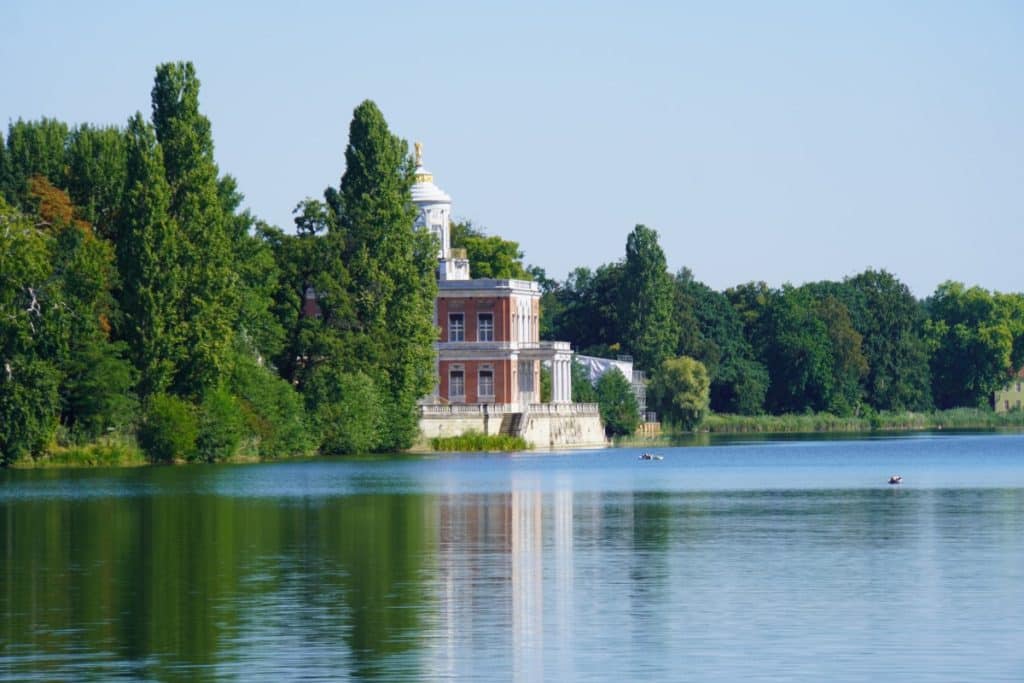
The king chose the landscaped parks of Wörlitz as a model for the design of the park and commissioned a Wörlitz gardener to implement it. He created a park based on the English model, recreating the natural surroundings and allowing the trees and plants to grow as freely as possible. In order to integrate the newly emerging rural idyll into the planning, cows grazed in the New Garden. The milk was processed in the dairy located in the park.
Over the years, the New Garden became increasingly overgrown. When Lenné came to Potsdam in 1816, he was given the task of redesigning the park. He created meadow areas, wide paths and garden areas. In addition, visual axes were created that provided views to Peacock Island, Glienicke, Babelsberg and Sacrow.
Heilige See (Holy Lake)
The central point in the New Garden is the Holy Lake. A large part of the park is located directly on the lake shore.
The north-south extension is about 1.3 kilometers and at the widest point is a good 400 meters. The lake is fed exclusively by groundwater, there are no surface tributaries. There is a tributary to the Jungfernsee, which belongs to the Havel, via the dammed Hasengraben. The damming of the Hasengraben is necessary to prevent the poorer quality water from the Havel from flowing into the lake. In addition, the impoundment regulates the water level of the lake and thus prevents the wooden foundation piles of the Marble Palace from running dry.

I entered the New Garden at the southern tip of the lake and took a beautiful park walk from there.
Sights in the New Garden
The garden is actually ideal for a break in the middle of the city at any time of year. The wide paths invite you to take a walk and many a bench with a fantastic view tempts you to take a break.
But there is much more to discover. Friedrich Wilhelm not only had the park built, but also some interesting and unique buildings.
At the starting point of my tour through the park, I immediately discover the first highlight of the tour.
Gothic library
The Gothic Library is an octagonal pavilion-like tower building with two floors. It is enclosed by a four-sided arcade.
The building was designed by Carl Gotthard Langhans, who took Gothic chapels as his model. The basement has large window fronts on each side. The upper floor is reached by a spiral staircase decorated with a railing, which is located outside.

Immediately after its completion, three bookcases were placed in the basement, which contained French classical literature. On the upper floor there were four cabinets containing German classics and writings of the Rosicrucians.
Since 1930 there are no more books in the Gothic Library. All books had been moved to the Potsdam City Palace and burned during bombing raids in 1945. The Gothic Library was also damaged during World War II. The foundation slipped in the direction of the lake. Since no restoration measures were taken, the building visibly deteriorated and soon only a ruin stood at the Holy Lake. It was not until 1995, with the help of subsidies, that it was possible to reconstruct the building in a manner befitting a historic monument.

Today the upper floor is closed off and a look through the windows allows to get an impression of the lower floor. However, this one did not excite me much, because during my visit the room looked more like a storeroom. Much nicer I found the arcade and the beautiful view from there over the lake. I would have loved to sit there in a deck chair and read a good book.
Orangery
My way led next to the Orangerie in the New Garden. On the east side of the building, I discover something that I actually did not expect here. A breath of Egypt in the middle of Potsdam! The Egyptian portal at the Orangerie is guarded by a sphinx, in two wall niches are black colored statues of Egyptian gods.

In the Orangery, in addition to two plant halls, there is also the wood-paneled Palm Hall, where public concerts were held. If you were lucky, you could even listen to the king play the cello.

In front of the Orangerie I walk through a beautifully landscaped garden. Everywhere the plants bloom and on a bench I make a small break in the shade, before I make my way to the red shimmering marble palace.
Marble Palace – the new palace of Frederick William II.
The Marble Palace in the New Garden was the summer palace of the king. It stands directly on the Holy Lake and for me is one of the most impressive buildings in the park.

The castle was built of red brick. It has two floors and on the flat roof there is a round temple, which served as a “lookout point”. From up there you should be able to see, for example, the castle on Peacock Island. On the lake side there is a large terrace with a staircase that reaches down to the lake. From there, the king liked to take long boat trips.
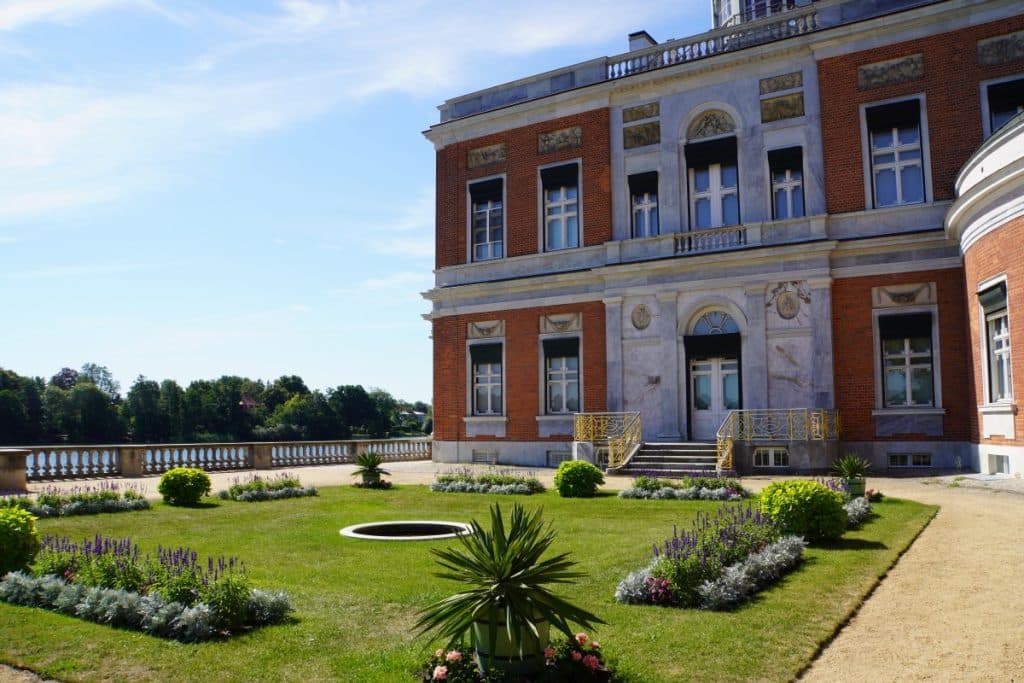
When it became increasingly difficult for the king to climb stairs, single-story side wings were built in 1797. In addition, galleries were created to connect the new parts of the building. The columns were made of recycled material. The procurement of Silesian marble, which was already used in the “old” part of the castle, was quite expensive. So the idea was to use columns from the marble colonnade in the park of Sanssouci. These originally stood on the main avenue, but had become dilapidated.

The extensions had not yet been completed when Frederick William II died in the Marble Palace on November 16, 1797.
Frederick William III, his son and successor, had the exterior completed, but did not take care of the interior design. This was not completed until 1843-48 and then used by royal summer guests. Later Prince Wilhelm (later Emperor Wilhelm II) and his family moved into the Marble Palace until his accession to the throne in 1888.
After the end of the First World War, the time of the monarchy in Germany also ended. In 1926, the Marble Palace in the New Garden passed into the administration of the Prussian Palace Department, which opened a palace museum there in 1932. Then, when an incendiary bomb hit the main building at the end of World War II, large parts of the interior and also original plans for the New Garden were destroyed. The use as an officers’ mess by the Red Army also inflicted great damage on the building and its interior.

From 1961, the Marble Palace housed the German Army Museum of the National People’s Army. The interior and exterior housed war equipment, which was completely removed in 1989. After reunification, the Palace Department restored the 40 interior rooms and in 2009 the restoration of the exterior facade was completed. Since 2018, the exterior has been completed and now you can admire the Marble Palace in its old beauty.
I have not yet made a tour of the beautiful building. But around the building I went. Thereby I was impressed by the wonderful terrace directly at the lake. Sitting here, eating a big sundae and drinking coffee would have pleased me at over 30 degrees. Unfortunately, this is not possible. The entrance area with the gallery is the second view of the Marble Palace, which I liked very much. Here is a landscaped garden in front, which offers a beautiful view of the summer palace.
Castle kitchen
As I stand on the steps of the Marble Palace, I spot a building a little below where I am standing. It looks dilapidated and almost like a buried temple. But it is the palace kitchen. This was created just so in 1788/90.
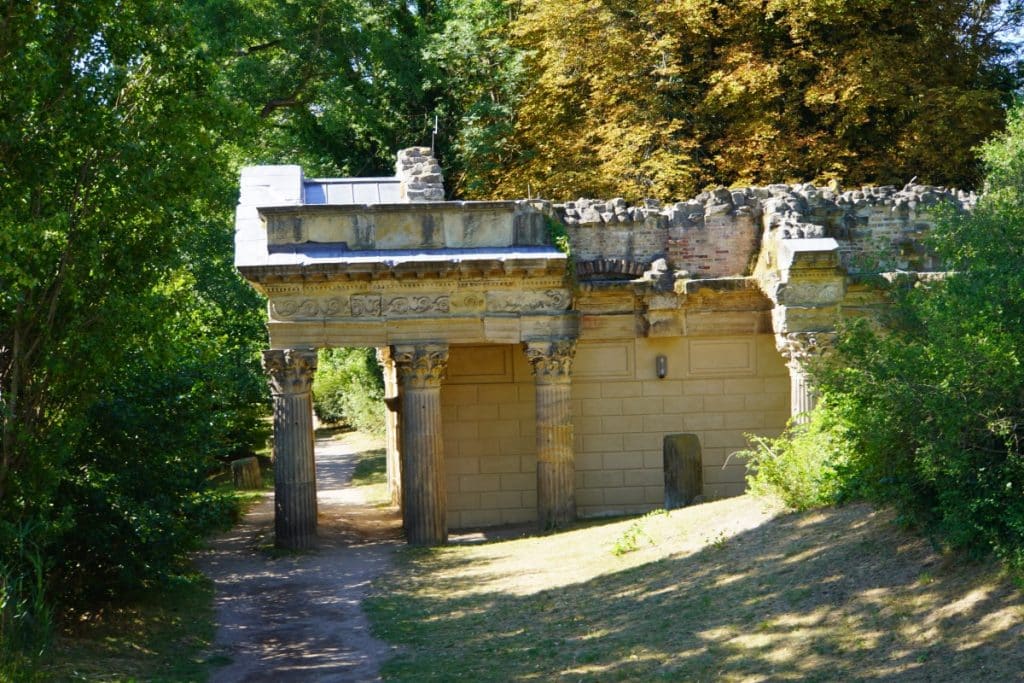
Actually, a sensible idea not to put the kitchen directly in the castle. So no food smells, no noise and you are protected from a possible fire hazard, especially when cooking on an open fire. However, to carry the finished food into the castle in wind and weather is certainly not so great either. The planner of the kitchen must have thought so, too, and so an underground corridor to the castle was built.
What is a pyramid doing in the New Garden?
Following the path, I walk along wide meadows that are interrupted by individual groups of trees. Another unique structure in the New Garden shimmers through between the trees. I discover a pyramid in the middle of Potsdam!

But this structure is not a tomb, as I first suspected. This is an oversized refrigerator!
When in winter the holy lake was frozen, one took the ice and brought it into the pyramid built in 1791/92. The lowest level is about 5 meters in the ground and from there the ice cooled the interior so that food could be stored longer.
Cecilienhof Palace
One of the newer buildings in the New Garden is the Cecilienhof Palace. Emperor Wilhelm II had it built in 1914-1917 for the crown prince and his wife Cecilie. The palace in English Tudor style is the last palace built by the Hohenzollerns.

The planning and management of the construction was the responsibility of Paul Schultze-Naumburg, who strongly adhered to the wishes of the couple. The exterior facade is dominated by brick and half-timbered elements made of dark oak. I notice the many chimneys as I walk around the building. Each one looks different, turning the roof into a small art exhibition.

Several parts of the building were created, all of which are interconnected and arranged around several beautifully designed courtyards. Some of the courtyards can be entered free of charge.
After the abdication of the emperor in 1918, all buildings initially fell to the state. In 1926 Wilhelm and Cecilie got the castle back as private property and lived there until their flight in 1945. In September 1945 the Soviet occupying power expropriated the Hohenzollerns. For many years the family tried to get their property back, but finally renounced their claims in 2023.

Cecilienhof Palace is known as the site of the Potsdam Conference, which took place there from July 17 to August 2, 1945. Here the four victorious powers met after the Second World War and decided on the future of Germany. Today, the interior houses a museum and a memorial to the Potsdam Agreement.
From the outside the castle is worth seeing and I take myself on my tour around the building certainly for the hundredth time to visit the museum.

My discovery tour continues first through the New Garden.
Borkenküche (Bark kitchen)
A very unusual building attracts my eyes next.
Not far from the castle stands since 1796 a round forest cottage (today only a replica). It is covered with oak bark and has a roof made of reeds. Here towered a chimney, on which sits an owl.

The bark kitchen really served as a kitchen, here one prepared the meals and the tea for the companies in the mussel grotto.
Not far from the bark kitchen I discover a sign to the grotto.
Crystal and shell grotto
A grotto was built directly on the shores of Lake Jungfernsee in 1791-94. At the request of Frederick William II, this facility should look as natural as possible and blend with the landscape. What looks rather plain from the outside was all the more ornate from the inside. There were three interior rooms, which looked unique, for example, with mirrors, colored glass, shells and an ornate ceiling painting. This is where “hidden” tea parties were held.

After the grotto was located on the border strip during the time of the Berlin Wall and visibly deteriorated, it is now being restored step by step.

I must admit, after reading about the Crystal and Shell Grotto, I had great expectations for the structure. Unfortunately, during my visit it turned out that from the outside the facility is completely unspectacular. Possible accesses to the interior are blocked and when I look through one of the grids, it looks more like a storage room and not a beautiful design. Only a look at the ceiling shows that something very special was once created here. I recognize remains of the ceiling painting, on the basis of which one can guess some things.
Meierei (dairy farm)
Standing on the lawn in front of the grotto, I look around and discover the Meierei, built according to plans by Carl Gotthard Langhans. It stands in the New Garden on the northeastern tip and served to supply the court society.
After several extensions, a pump house was added to ensure the irrigation of the New Garden.

From 1918 until the Second World War, the Meierei was a popular excursion restaurant, which was severely damaged during the war. Only since 2003 you can go there again to eat.
But I was drawn in the opposite direction along the shore of the Jungfernsee, there I wanted to see the last place of my planned tour.
Hermitage at the Jungfernsee
I arrive at an inconspicuous building clad in oak bark. This is completely closed and nothing reminds today of the former splendor that was present inside.
In 1796, Frederick William II commissioned the master builder Carl Gotthard Langhans to erect the pavilion. The result was a room without windows, lit only by a skylight. Inside, white Italian marble and black Brabant decorated the floor. In the center of the room was a world map inlaid into the floor. On the wood-paneled walls hung pictures of astronomical instruments and two tables and sofas stood in the room.

This building was also “in the way” during the construction of the Wall and was completely demolished. Parts of the interior were saved by the Palace Department. Since 2007, the building of the Hermitage, but without interior decoration again in the New Park. It’s a pity, I had hoped to have a look into the hermitage.
On my way to the park exit at the Hasengrabenbrücke I enjoy once again the view of the Marble Palace. Although I “only” went for a walk, I was on the road for something like 3 hours and so slowly the legs got tired. The New Park is a great place for a walk.

Address:
Neuer Garten
Am Neuen Garten
14469 Potsdam
Opening hours:
daily: 8 am until nightfall
Entrance fees:
The visit to the park is free of charge.
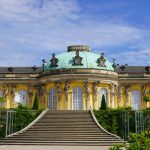





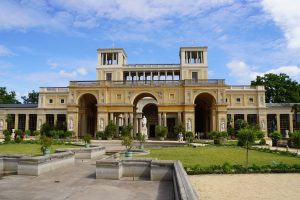









Leave a Reply